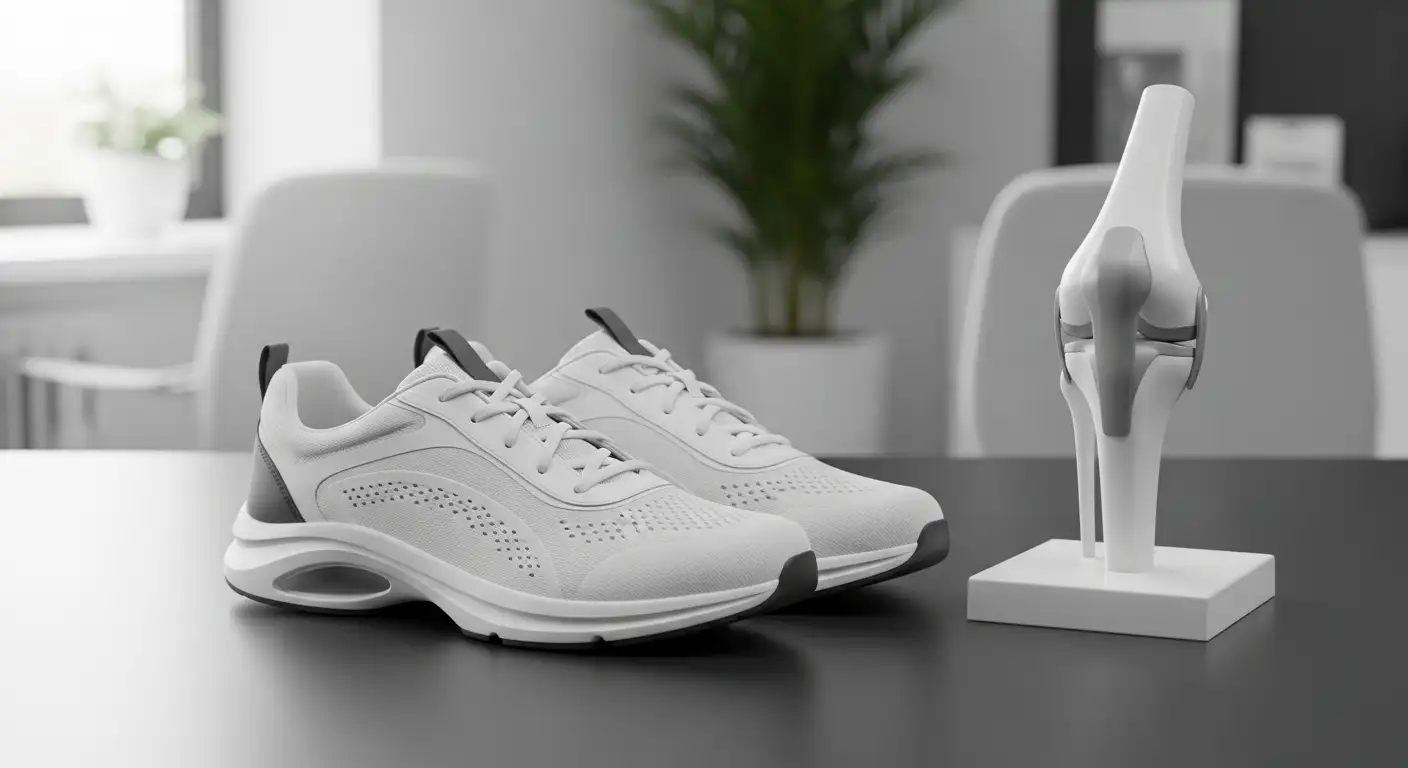Understanding Gout in the Knee
Definition and Causes of Gout
Gout is a type of inflammatory arthritis that can develop in any joint, including one or both knees. It is characterized by the accumulation of uric acid in the body, which forms sharp crystals that lead to intense pain, swelling, and tenderness in the affected area. The condition often results from the breakdown of purines found in various foods, as well as other risk factors such as genetics, high blood pressure, and heart failure.

CauseDescriptionUric Acid BuildupHigh levels of uric acid form crystals in joints.GeneticsFamily history can increase susceptibility.DietFoods high in purines, such as red meat and seafood, can trigger gout attacks.Health ConditionsHigh blood pressure and heart failure can heighten risk.
Symptoms and Diagnosis
Symptoms of gout in the knee can vary, but they typically include significant pain, discomfort in surrounding areas, and unpredictable flare-ups that can last for various durations. These flare-ups usually occur suddenly and often during the night.
Diagnosis of gout tends to be straightforward; however, some conditions can mimic the symptoms. Healthcare professionals may use several methods to confirm a diagnosis, including physical examinations and possibly analyzing fluid from the affected joint to detect uric acid crystals [2].
SymptomDescriptionIntense Joint PainSudden, severe pain in the knee joint.SwellingSwollen appearance of the knee.TendernessSensitivity to touch or movement.Limited Range of MotionDifficulty moving the knee due to pain.
Gout most commonly affects the joint at the base of the big toe, but it can also affect the knees and other joints [3]. Understanding these aspects can help individuals recognize and address the condition early. For those exploring further, you can check pictures of gout in knee for visual references.
Effects of Gout in the Knee
Gout in the knee can have serious effects if not properly managed. Understanding these effects is crucial for individuals experiencing symptoms or seeking to prevent complications.
Complications of Untreated Gout
Leaving gout untreated can lead to multiple complications. One of the most significant risks is permanent damage to the knee joint. Chronic inflammation caused by gout can result in the formation of uric acid crystal lumps known as tophi. These tophi increase swelling, tenderness, and can severely affect the joint's range of motion during flare-ups [1].
ComplicationDescriptionPermanent Joint DamageSevere and lasting damage to the knee joint, leading to loss of function.Formation of TophiUric acid crystal lumps under the skin that cause swelling and pain.DeformityAltered shape of the knee joint affecting mobility.Chronic InflammationPersistent swelling that can lead to further joint damage.Need for SurgerySurgical intervention may be required to alleviate pain or correct damage.
Chronic gout can lead to issues beyond the knee joint, including kidney stones, as urate crystals can accumulate in the urinary tract, causing painful obstructions and damage [4].
Impact on Joint Health
The impact of gout on joint health is profound. Chronic inflammation and the development of tophi can lead to irreversible joint damage, deformity, and stiffness. In some cases, this may necessitate surgery to repair the damage done to the joint.
Individuals experiencing persistent symptoms should seek medical advice to mitigate these risks. By managing gout effectively, such as through lifestyle changes and medication, they can avoid complications and maintain joint health. For further information on related conditions, visit sections that discuss symptoms and diagnosis of gout.
Gout in the knee can also increase the risk of additional health concerns, including kidney disease, as recurrent accumulation of urate crystals can cause damage and scarring to the kidneys over time. Understanding these impacts reinforces the importance of early management and treatment strategies.
Managing Gout in the Knee
Gout in the knee requires effective management to alleviate symptoms and prevent complications. This involves both medication options and lifestyle changes.
Medication Options
Several medications are available to help manage gout symptoms and lower uric acid levels in the body. Treatment typically focuses on reducing inflammation during acute attacks and managing chronic symptoms to prevent future flare-ups.
Medication TypePurposeNonsteroidal Anti-Inflammatory Drugs (NSAIDs)Reduce pain and swelling during a gout attack.ColchicineHelps decrease inflammation and is particularly effective if taken at the first sign of a gout attack.CorticosteroidsPrescription medicines used for severe pain and inflammation when NSAIDs are not effective or suitable.Uric Acid Lowering Medications (e.g., Allopurinol)Help manage hyperuricemia by lowering urate levels in the blood over time.
For a more detailed look at these medications, consult resources like NIAMS.
Lifestyle Changes for Prevention
Addressing lifestyle factors can significantly impact the frequency and severity of gout attacks. These changes can help manage hyperuricemia and improve overall joint health.
Lifestyle ChangeRecommendationsDiet ModificationsReduce consumption of purine-rich foods (e.g., red meat, seafood) and alcohol. Increase intake of low-fat dairy, fruits, and vegetables.HydrationDrink plenty of fluids, particularly water, to help flush uric acid from the body. Aim for 8-10 glasses daily.Weight ManagementMaintain a healthy weight to reduce joint stress and lower uric acid levels.ExerciseEngage in regular low-impact activities to promote joint health. Check out the best exercise for hamstrings or explore resistance training through resistance band leg press.
Implementing these lifestyle changes not only helps prevent gout flare-ups but also supports overall joint health. Individuals experiencing joint discomfort or other symptoms can seek guidance on maintaining joint health through various methods, including knee sleeves such as the ACE knee sleeve or braces like the hyperextension knee brace. For more insights on managing knee pain and understanding related conditions, consider exploring available topics like my knee feels like it needs to pop but won't or why does my knee lock up.
Diet and Gout
Diet plays a crucial role in managing gout, particularly for those experiencing pain in the knee. Proper dietary choices can help control uric acid levels, reducing the frequency and severity of gout attacks.
Gout-Friendly Foods
In selecting foods that can help mitigate gout symptoms, it's important to focus on items that lower uric acid levels. Some beneficial options include:
Food GroupRecommended FoodsVegetablesSpinach, AsparagusLegumesBeans, Lentils, Soy productsFruitsCherries, StrawberriesWhole GrainsOats, Brown riceLow-Fat DairyYogurt, Skim milk
These foods are associated with a lower risk of gout attacks and do not contribute to increased uric acid levels. While Vitamin C, found in various fruits and drinks, can aid in lowering uric acid levels, caution should be taken with high-fructose drinks like orange juice due to their potential to raise uric acid levels. Moderation is key.
Importance of Hydration
Staying hydrated is essential for managing gout. Drinking adequate fluids helps the kidneys eliminate uric acid effectively, which is vital for preventing gout flares. It is recommended to consume between 8 to 16 cups of fluids daily, with at least half of that intake being water.
Hydration TipsRecommendationsDaily Fluid Intake8 to 16 cups, half from waterOptimal Hydrating BeveragesWater, Herbal teasModerate ConsumptionLimit alcohol and sugary drinks
Proper hydration not only supports kidney function but also reduces the risk of developing additional complications associated with gout, such as kidney stones. Individuals experiencing knee pain should pay attention to their dietary habits and hydration levels to help manage their symptoms effectively. For further understanding of knee-related issues, check out articles on my knee feels like it needs to pop but won't and why does my knee lock up.
Treatment and Care for Gout
For individuals experiencing gout in the knee, effective treatment and care can significantly improve symptoms and quality of life. This section will explore medication options, therapy methods, and the role of specialist care and support.
Medications and Therapies
To address a gout flare-up, healthcare professionals may recommend a variety of medications. The primary goal of these treatments is to decrease inflammation, relieve pain, and reduce joint swelling.
Medication TypeExamplesFunctionCorticosteroidsPrednisoneDecrease inflammation and pain relief. Can be prescribed orally or injected into the joint. (WebMD)Nonsteroidal Anti-Inflammatory Drugs (NSAIDs)Ibuprofen, NaproxenReduce pain and inflammation.Topical TreatmentsDiclofenac (Voltaren), Gout BusterApplied to the skin to alleviate swelling, stiffness, and joint pain. (WebMD)
Managing hyperuricemia, the underlying cause of gout, is also critical. Different medications can help lower urate levels in the body, which in turn reduces the frequency of gout attacks [6].
Making lifestyle changes is equally important in managing gout effectively. Diet modifications and controlling risk factors can help reduce the occurrence of gout flares and symptoms. Incorporating a healthy diet may be beneficial for overall joint health.
Specialist Care and Support
Individuals suffering from gout should consider seeking specialist care to manage their condition properly. Healthcare providers, such as rheumatologists, specialize in treating gout and can offer tailored treatment plans based on individual needs.
Accessing comprehensive support, including educational resources, can enhance the management of gout. Support groups often provide valuable information about coping strategies and lifestyle adjustments that directly impact gout symptoms.
Utilizing both medication and specialist support creates a multifaceted approach to effectively treat gout. For more information on related issues, explore topics such as the best exercise for hamstrings or check if your knee is locking up with our article on why does my knee lock up. Understanding these aspects can foster a healthier lifestyle and improve overall joint function.
Risk Factors and Complications
Gout in the knee presents several risk factors and complications that can significantly impact an individual's quality of life. Understanding these issues is crucial to managing the condition effectively.
Formation of Tophi
One of the significant complications associated with gout is the formation of tophi. Tophi are lumps made of uric acid crystals that can develop under the skin near joints and on cartilage. If left unmanaged, gout can lead to chronic inflammation and the accumulation of tophi, which can result in permanent damage to the knee joint [1].
The presence of tophi can worsen the symptoms of gout, leading to additional swelling and tenderness, particularly during flare-ups. Over time, chronic gout-related issues can cause joint deformity and stiffness, sometimes necessitating surgical intervention to repair any damage caused by the tophi.
ComplicationDescriptionTophi FormationClumps of urate crystals under the skin, which can cause pain and swelling.Joint DamagePermanent damage, deformation, and stiffness of the knee joint.SurgeryMay be required in severe cases to correct joint problems.
Kidney Stones and Kidney Disease
Individuals with gout are at an increased risk of developing kidney stones due to the buildup of urate crystals in the urinary tract. These crystals can accumulate and transform into stones, leading to significant discomfort and potential complications.
The formation of kidney stones can lead to damage and scarring in the kidneys. If untreated, this can increase the likelihood of developing chronic kidney disease over time [4]. Managing gout is essential not only for preventing joint-related complications but also for protecting renal health.
ComplicationDescriptionKidney StonesResult from the accumulation of urate crystals, leading to severe pain.Kidney DamageDamage and scarring from untreated kidney stones can lead to chronic kidney disease.
Recognizing these risk factors and complications is vital for anyone dealing with gout in the knee. Proper management can help prevent serious health issues from developing, encouraging better overall joint and kidney health. Learn more about pictures of gout in knee for visual references regarding this condition.
References
[2]:
[3]:
[4]:
[5]:
[6]:





